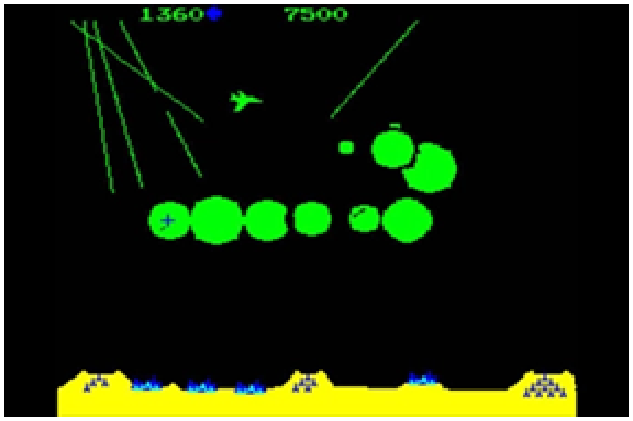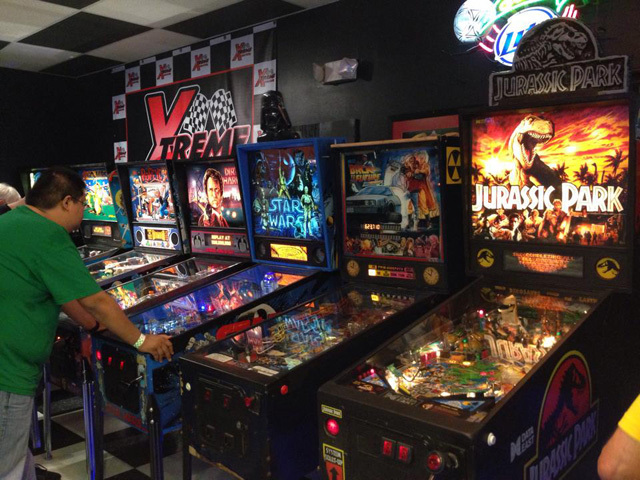In this month’s edition of Getting Good, we’re going to talk about another oldie but goodie; a game that was quite popular back when it was first released in 1980. Missile Command was developed and published by Atari and featured a gameplay that we can only describe as, “Like Space Invaders, but on steroids”.
True to its name, Missile Command is about taking control of several missile silos and, using their limited supply of warheads, blowing up the incoming wave of enemy missiles that are raining on the field, all with the goal of keeping your cities safe. So, like Space Invaders, your goal is to take control of a series of elements on the bottom of the screen and use them to blow up other elements that are making their way towards the bottom. However, unlike Space Invaders, your silos are immobile, don’t have unlimited ammo, and your enemies are exceedingly fast, can come from any direction, and don’t follow a set pattern.
Rounds in Missile Command last only a few short seconds, regardless of whether you’re actually playing or not. And the reason we say this is because, even if your missile silos are blown up and you’re left defenseless, it’s still possible to survive stages if any of the remaining enemy missiles don’t hit your cities. And when it comes to the latter stages, there’s a good chance that most of your rounds will finish with all your three silos disabled, and with you crossing your fingers hoping that a stray missile doesn’t hit your remaining cities.

And with that being said, let’s go ahead and hop into our guide on how to get good at Missile Command.
Gameplay Basics
Like with many retro arcade titles, the gameplay in Missile Command takes place in short levels with increasing difficulty. Regardless of the level, however, the player always begins with three missile silos; one on each side of the screen, and one in the middle. Between the middle and each of the lateral silos rest three cities, for a total of six. These cities are the ones you must protect, as the game is over if you lose all of them to the onslaught of enemy explosives.
What makes Missile Command difficult, aside from the increasing speed at which missiles fall to the ground as you progress through the levels, is the fact that your destroyed cities remain as such in the following levels. In this sense, if you lose a city, it’ll stay that way and make it much harder to survive subsequent rounds. However, destroyed cities regenerate between rounds for every 10,000 points you manage to score.
As for the controls, they’re quite simple: The player has a trackball which is used for moving the cursor. Additionally, the player has three buttons, each of which can control a different silo. It’s important to distinguish which silo you want to shoot from as it would make the missiles reach their destinations much faster depending on where you want to shoot. It’s worth mentioning here that missiles explode in the location designated by your cursor. This is important to know since you can simply launch a unit ahead of the enemy explosives’ trajectories and catch several of these elements in the air with just one of your own missiles.
Each or your silos only have 10 missiles per level, and you can’t shoot any more if you run out. Similarly, while enemy missiles often target your cities, they also target your silos. If a silo is destroyed, it’s disabled for the remainder of the level and all its remaining ammo is lost.
Players can score points in Missile Command by destroying incoming missiles and other enemies. Also, at the end of each level, additional points are awarded for every surviving city, as well as for each unused missile.
The Different Enemies
As we mentioned above, while the main enemies you’ll need to defend against are standard missiles, there are also a few other enemies in Missile Command. Here’s a list of all the baddie you’ll encounter in the game:
- Missiles: Your standard falling missile, represented by a tiny yellow dot that leaves a red trail in its wake. While many missiles fall straight down, others can actually split into several other explosives, which increases their threat as you’ll have to guard against three missiles instead of one. Each missile is worth 25 points.
- Smart Bombs: Represented by green dots with a red outline, smart bombs are much more elusive and deadly than standard missiles, particularly because they tend to avoid explosions that are directly in their path. Therefore, the only way to destroy them reliably is by aiming so that they explode precisely on top of the smart bombs. Alternatively, you could also shoot two missiles so that they are caught between both explosions with no way to avoid them. Each smart bomb is worth 125 points.
- Bombers and Satellites: These elements appear from the sides of the stages moving across the level in a straight line, and dropping additional missiles along the way. Destroying them fast is recommended since they tend to fly quite low, and any missiles that they drop are basically a death sentence to any city or silo. Each satellite and bomber are worth 100 points.
Tips and Tricks
Missile Command is a game that can quickly get out of hand due to the number of incoming bogeys in every stage. However, there are a few things you can keep in mind to help you stay safe in your journey:

- All elements, with the exception of the Smart Bombs, travel in a straight line. For this reason, the easiest way to destroy them is to shoot straight ahead of where they currently are and let the explosion of your missile destroy the enemy element. You can destroy several targets with just one missile with this technique.
- When it comes to destroying incoming threats, use the lateral silos for when the targets are high up in the sky, and use the middle silo to deal with threats that are closer to the ground. This is because missiles from the lateral silos often have to travel farther to reach their target, while the middle silo is often closer to any incoming threat, making it better for targets that manage to creep through your defenses.
- It’s better to destroy missiles as fast as possible to avoid them splintering into additional threats. However, if a missile DOES split, they often tend to align with other incoming targets. In this sense, try to hit as many targets as possible with every missile to avoid getting overwhelmed.
- If you’ve already gotten through most of the level, and you see a smart bomb headed for one of your silos, and another missile going for one of your cities, it’s better to focus on defending your cities. Your silos regenerate every level, your cities don’t. With that being said, while it’s obviously better to destroy every single target, it’s possible to survive stages with no silos remaining, as long as at least one city is left standing.
- As we mentioned above, destroyed cities regenerate between stages for every 10,000 points.
- In the more advanced stages, losing cities will become inevitable. When you feel that you can’t keep up with the incoming threats and are spreading yourself too thin, choose only one side of the map and focus exclusively on protecting the three cities on that side.
Thanks for reading! Here at PrimeTime Amusements, we like to keep ahead of the curve in arcade game rental and sales and pride ourselves in providing the best service in the country. If you’re looking for a game in particular, or have a few questions about the industry, feel free to give us a call at 1.800.550.0090 or to swing by at 5300 Powerline Rd. Suite 210, Ft. Lauderdale, Florida, 33309.





